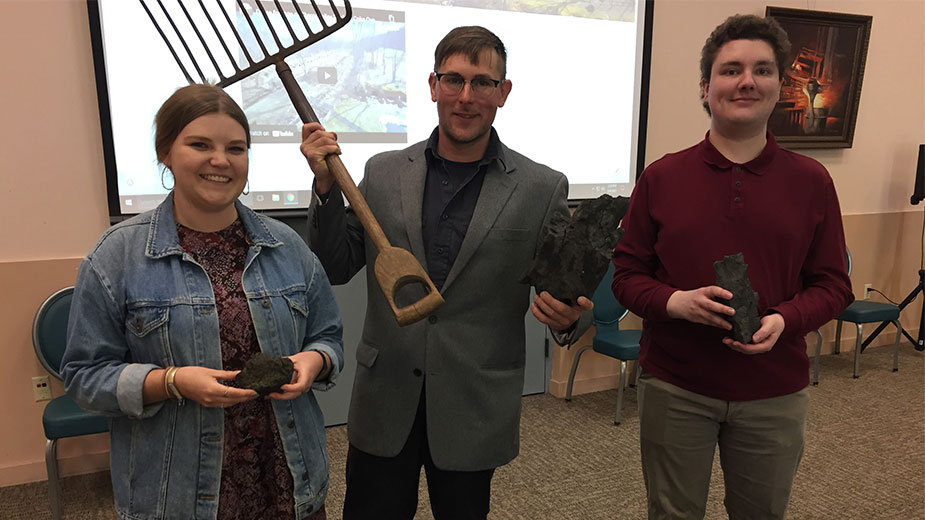YSU Students Explore the Fuel that Fed the Iron and Steel Industry
YOUNGSTOWN, Ohio – Students from Youngstown State University’s applied history program have developed a new virtual exhibit for the Youngstown Historical Center of Industry & Labor.
Their project, “Carbon Footprints: The Methods of Making Coke,” is especially relevant to the region’s industrial heritage as it explores the process and importance of manufacturing purified coal – better known as coke – an ingredient that fired the Mahoning Valley’s blast furnaces throughout the 19th and 20th centuries.
“Coal has impurities,” Jacob Harver, a student in professor Thomas Leary’s Museum Curation II class, said Thursday. “One of the big enemies is sulfur. They want to get the sulfur out of there so it burns clean in the blast furnaces.”
Harver and fellow classmates Hannah Klacik and Brian Pete were on hand at the museum to deliver findings that touched upon early and modern methods of coke production, and how byproducts from the manufacturing process are used. A fourth student who participated in the project, Brooke Bobovnyik, could not attend.
Coke is created when coal is cooked at roughly 2,000 degrees, essentially baking out impurities such as benzene, torulene, sulfur and moisture. The coke is then fed into furnaces critical to iron and steel manufacturing.
“They measure the quality of the coke based on how pure the carbon is, the low moisture and how strong it is,” Harver said.
During the first half of the 20th century, coke furnaces dotted the banks of the Mahoning River, as major steelmakers such as Youngstown Sheet & Tube’s Brier Hill and Campbell Works, and Republic Steel in Warren all operated nearby coke plants.
Early iron furnaces in the Mahoning Valley were fed with charcoal. However, continued deforestation drove the effort to find an alternative fuel: coal.
Coal in the region was plentiful, so there was no shortage of supply. Brier Hill coal, discovered on the Tod farm in Youngstown early in the 19th century, proved to be so pure that the coking process was unnecessary. Coal dug from other areas, however, required further processing.
Elsewhere, the remnants of earlier furnaces dating to about the 1860s are still visible. In Leetonia’s Cherry Valley, for example, rows of 200 brick “beehive” ovens once owned by the Leetonia Coal & Iron Co. still stand, its grounds now converted into a public park, Klacik said.
The virtual exhibit uses aerial drone footage to examine the entire site, the oldest coke ovens still intact in the region, she said. “We were also able to develop a relationship with the public library there,” she added.
For the project, Harver made trips to several coke production sites, such as the SunCoke plant along the Ohio River near Portsmouth, the shuttered Shoaf furnaces just southeast of Pittsburgh and was able to retrieve some samples from Sheet & Tube’s Campbell Works.
Today, just one coke operation in the Mahoning Valley – Cleveland Cliffs’ coke mill in Warren – is operational.
Coke manufacturing could also be dangerous. Aside from the everyday risks of shoveling coal into high temperature ovens, workers were likely to face health complications because of the dangerous byproducts of the production process, said Pete said.
“It was a very dangerous and dirty job,” he said, noting the plants produced a “whole grocery list of carcinogenic agents.”
Those living nearby an operating coke plant are likely to be subjected to a sulfuric, rotten egg-smell, he said, but new technology and means of controlling emissions have alleviated much of these risks in more modern operations.
Byproducts from the coke-making process have always been put to use, Harver said, noting that gasses released from the plants have been harnessed, recycled and used in manufacturing operations that produced everything from aspirin to TNT.
Modern heat recovery operations are today found in plants such as SunCoke’s operation on the Ohio River, he added.
Leary, a history professor and certificate director of the applied history program at YSU, said this is the first class that he’s organized in which students have produced a virtual exhibit. “It was partly the result of COVID, but also partly because of the availability in this format to use some of these new techniques like drone footage.”
The project points to the use of how technology could enhance future exhibits at the Center for Industry & Labor, he said.
“We’re experimenting with what exhibits in this building may look like in the future – very different from what most people expect to see in a case or on a wall,” he said.
The virtual exhibit can be viewed HERE.
Pictured: Students Hannah Klacik, Jacob Harver and Brian Pete display chunks of coke used in iron and steel manufacturing.
Copyright 2024 The Business Journal, Youngstown, Ohio.



